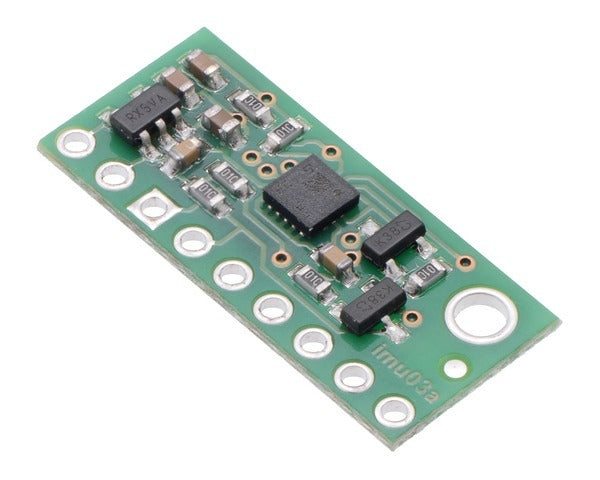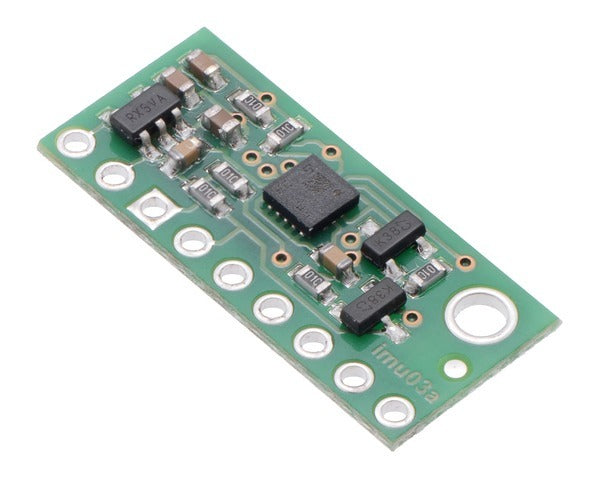LSM6DS33 3D Accelerometer and Gyro Carrier with Voltage Regulator
LSM6DS33 3D Accelerometer and Gyro Carrier with Voltage Regulator
4 in stock
Couldn't load pickup availability
This board is a compact (0.4″ × 0.9″) breakout board for ST’s LSM6DS33 inertial module, which features a 3-axis digital linear accelerometer and 3-axis digital rate gyroscope; we therefore recommend careful reading of the LSM6DS33 datasheet (1MB pdf) before using this product. The LSM6DS33 is a great IC, but its small package makes it difficult for the typical student or hobbyist to use. It also operates at voltages below 3.6 V, which can make interfacing difficult for microcontrollers operating at 5 V. This carrier board addresses these issues by incorporating additional electronics, including a 3.3 V voltage regulator and level-shifting circuits, while keeping the overall size as compact as possible. The board ships fully populated with its SMD components, including the LSM6DS33, as shown in the product picture.
The LSM6DS33 inertial measurement unit (IMU) has many configurable options, including dynamically selectable sensitivities for the accelerometer and gyro, a choice of output data rates, and two independently-programmable external inertial interrupt pins. The accelerometer and gyro can be individually turned on and off to save power. The sensor can be configured and its readings can be accessed through a digital interface, which can be configured to operate in either I²C (TWI) or SPI mode.
The six independent acceleration and angular rate readings (sometimes called 6DOF) provide data that a microcontroller or computer can use to calculate the orientation of the LSM6DS33 on two axes (roll and pitch; a magnetometer is generally required to compute yaw accurately). With an appropriate algorithm, the gyro can be used to very accurately track rotation on a short timescale, while the accelerometer can help compensate for gyro drift over time by providing an absolute frame of reference.
The carrier board includes a low-dropout linear voltage regulator that provides the 3.3 V required by the LSM6DS33, which allows the sensor to be powered from a 2.5-5.5 V supply. The regulator output is available on the VDD pin and can supply almost 150 mA to external devices. The breakout board also includes a circuit that shifts the I²C clock and data lines to the same logic voltage level as the supplied VIN, making it simple to interface the board with 5 V systems, and the board’s 0.1″ pin spacing makes it easy to use with standard solderless breadboards and 0.1″ perfboards.
This LSM6DS33 carrier is pin-compatible with many of our previous ST I²C/SPI sensor carriers, including our LSM303D compass and accelerometer carrier and L3GD20H gyro carrier, and the orientation of the sensor axes is the same. However, since the ICs contain different sensors with different I²C addresses and configuration registers, code written to interface with another chip will need to be modified to work with an LSM6DS33.
For sensor fusion applications, our MinIMU-9 v5 and AltIMU-10 v5 inertial measurement units combine this LIS3MDL with anLSM6DS33 3-axis accelerometer and 3-axis gyro on a single board, providing nine independent readings that can be used to calculate an absolute orientation. The AltIMU-10 v5 also includes an LPS25H pressure sensor that can be used to calculate altitude.
Specifications
Dimensions: 0.4″ × 0.9″ × 0.1″ (10 × 23 × 3 mm)
Weight without header pins: 0.6 g (0.02 oz)
Operating voltage: 2.5 V to 5.5 V
Supply current: 2 mA
Output format (I²C/SPI):
Accelerometer: one 16-bit reading per axis
Gyro: one 16-bit reading per axis
Sensitivity range (configurable):
Accelerometer: ±2, ±4, ±8, or ±16 g
Gyro: ±125, ±245, ±500, ±1000, or ±2000°/s
A 1×9 strip of 0.1″ header pins and a 1×9 strip of 0.1″ right-angle header pins are included, as shown in the picture below. You can solder the header strip of your choice to the board for use with custom cables or solderless breadboards, or you can solder wires directly to the board itself for more compact installations.
The board has one mounting hole that works with #2 and M2 screws (not included).
Connections
Regardless of the interface being used to communicate with the LSM6DS33, its VIN pin should be connected to a 2.5 V to 5.5 V source, and GND should be connected to 0 volts. (Alternatively, if you are using the board with a 3.3 V system, you can leave VIN disconnected and bypass the built-in regulator by connecting 3.3 V directly to VDD.)
A minimum of two logic connections is necessary to use the LSM6DS33 in I²C mode (this is the default mode): SCL and SDA. These pins are connected to built-in level-shifters that make them safe to use at voltages over 3.3 V; they should be connected to an I²C bus operating at the same logic level as VIN. The remaining pins are not connected to level-shifters on the board and are not 5V-tolerant, but our 4-channel bidirectional logic level shifter can be used externally with those pins to achieve the same effect.
To use the LSM6DS33 in SPI mode, four logic connections are typically used: SPC, SDI, SDO, and CS. These should be connected to an SPI bus operating at the same logic level as VIN. The SPI interface operates in 4-wire mode by default, with SDI and SDO on separate pins, but it can be configured to use 3-wire mode so that SDO shares a pin with SDI.


